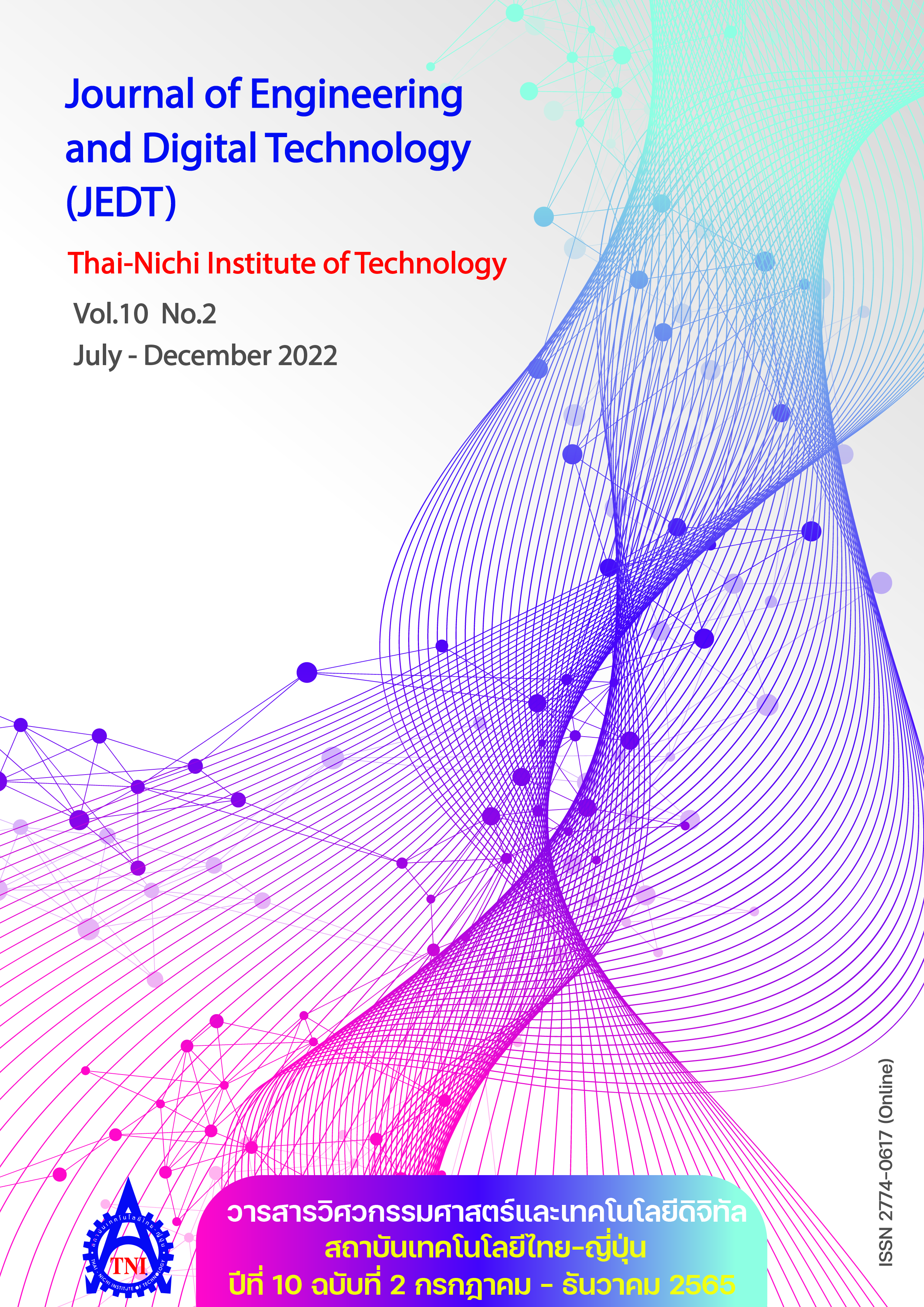การออกแบบและควบคุมสำหรับหุ่นยนต์ดุลยภาพด้วยตัวควบคุมพีดี และแอลคิวอาร์ โดยใช้โปรแกรม Simulink
Main Article Content
บทคัดย่อ
บทความนี้มีจุดมุ่งหมายที่จะแสดงให้เห็นถึงหลักการออกแบบของหุ่นยนต์ดุลยภาพของตัวควบคุมแบบ พีดี และแอลคิวอาร์ ในการออกแบบนั้น หุ่นยนต์ใช้หลักการเคลื่อนไหวแบบไดนามิกและกฎของนิวตัน แบบจำลองทางคณิตศาสตร์ของหุ่นยนต์ดุลยภาพจะไม่เป็นแบบเส้นตรง ดังนั้น หุ่นยนต์ต้องแปลงแบบจำลองทางคณิตศาสตร์ของหุ่นยนต์ดุลยภาพไม่เชิงเส้นให้เป็นแบบเชิงเส้น แบบจำลองทางคณิตศาสตร์ของหุ่นยนต์ดุลยภาพนำไปใช้กับการออกแบบตัวควบคุม ในการออกแบบตัวควบคุมหลักสำหรับหุ่นยนต์ปรับสมดุล ผู้วิจัยได้เลือกตัวควบคุมทั้งสองเพราะง่ายต่อการปรับให้เหมาะสมกับระบบของหุ่นยนต์ทรงตัว โดยเลือกใช้ Simulink จำลองการเคลื่อนที่และทดลองตรรกะของตัวควบคุมเพื่อทำให้หุ่นยนต์ทรงตัวให้มีเสถียรภาพ โดยการจำลองระบบของหุ่นยนต์ทรงตัวที่ใช้ในการออกแบบตัวควบคุม และเปรียบเทียบประสิทธิภาพของมุม และทรงตัวของหุ่นยนต์ เพื่อรักษาเสถียรภาพและขจัดสัญญาณรบกวนที่อาจเกิดขึ้นในระบบ ผลการทดสอบได้เปรียบเทียบค่าดัชนีสมรรถนะของระบบควบคุมหุ่นยนต์ดุลยภาพที่ใช้ตัวควบคุมทั้งสองแบบ การควบคุมระบบหุ่นยนต์ดุลยภาพจะใช้ตัวควบคุมในการรักษาเสถียรภาพของมุม และทรงตัวของหุ่นยนต์ดุลยภาพ จากผลการทดสอบพบว่าในการรักษาเสถียรภาพของหุ่นยนต์ดุลยภาพโดยใช้ควบคุมแบบแอลคิวอาร์ให้การรักษาเสถียรภาพดีกว่าตัวควบคุมแบบพีดี
Article Details

อนุญาตภายใต้เงื่อนไข Creative Commons Attribution-NonCommercial-NoDerivatives 4.0 International License.
นโยบายการรับบทความ
กองบรรณาธิการวารสารสถาบันเทคโนโลยีไทย-ญี่ปุ่น มีความยินดีรับบทความจากอาจารย์ประจำ และผู้ทรงคุณวุฒิในสาขาวิศวกรรมศาสตร์และเทคโนโลยี ที่เขียนเป็นภาษาไทยหรือภาษาอังกฤษ ซึ่งผลงานวิชาการที่ส่งมาขอตีพิมพ์ต้องไม่เคยเผยแพร่ในสิ่งพิมพ์อื่นใดมาก่อน และต้องไม่อยู่ในระหว่างการพิจารณาของวารสารอื่นที่นำส่ง ดังนั้นผู้สนใจที่จะร่วมเผยแพร่ผลงานและความรู้ที่ศึกษามาสามารถนำส่งบทความได้ที่กองบรรณาธิการเพื่อเสนอต่อคณะกรรมการกลั่นกรองบทความพิจารณาจัดพิมพ์ในวารสารต่อไป ทั้งนี้บทความที่สามารถเผยแพร่ได้ประกอบด้วยบทความวิจัย ผู้สนใจสามารถศึกษาและจัดเตรียมบทความจากคำแนะนำสำหรับผู้เขียนบทความ
การละเมิดลิขสิทธิ์ถือเป็นความรับผิดชอบของผู้ส่งบทความโดยตรง บทความที่ได้รับการตีพิมพ์ต้องผ่านการพิจารณากลั่นกรองคุณภาพจากผู้ทรงคุณวุฒิและได้รับความเห็นชอบจากกองบรรณาธิการ
ข้อความที่ปรากฏภายในบทความของแต่ละบทความที่ตีพิมพ์ในวารสารวิชาการเล่มนี้ เป็น ความคิดเห็นส่วนตัวของผู้เขียนแต่ละท่าน ไม่เกี่ยวข้องกับสถาบันเทคโนโลยีไทย-ญี่ปุ่น และคณาจารย์ท่านอื่น ๆ ในสถาบัน แต่อย่างใด ความรับผิดชอบด้านเนื้อหาและการตรวจร่างบทความแต่ละบทความเป็นของผู้เขียนแต่ละท่าน หากมีความผิดพลาดใด ๆ ผู้เขียนแต่ละท่านจะต้องรับผิดชอบบทความของตนเองแต่ผู้เดียว
กองบรรณาธิการขอสงวนสิทธิ์มิให้นำเนื้อหา ทัศนะ หรือข้อคิดเห็นใด ๆ ของบทความในวารสารสถาบันเทคโนโลยีไทย-ญี่ปุ่น ไปเผยแพร่ก่อนได้รับอนุญาตจากผู้นิพนธ์ อย่างเป็นลายลักษณ์อักษร ผลงานที่ได้รับการตีพิมพ์ถือเป็นลิขสิทธิ์ของวารสารสถาบันเทคโนโลยีไทย-ญี่ปุ่น
ผู้ประสงค์จะส่งบทความเพื่อตีพิมพ์ในวารสารวิชาการ สถาบันเทคโนโลยีไทย-ญี่ปุ่น สามารถส่ง Online ที่ https://www.tci-thaijo.org/index.php/TNIJournal/ โปรดสมัครสมาชิก (Register) โดยกรอกรายละเอียดให้ครบถ้วนหากต้องการสอบถามข้อมูลเพิ่มเติมที่
- กองบรรณาธิการ วารสารสถาบันเทคโนโลยีไทย-ญี่ปุ่น
- ฝ่ายวิจัยและนวัตกรรม สถาบันเทคโนโลยีไทย-ญี่ปุ่น
เลขที่ 1771/1 สถาบันเทคโนโลยีไทย-ญี่ปุ่น ซอยพัฒนาการ 37-39 ถนนพัฒนาการ แขวงสวนหลวง เขตสวนหลวง กรุงเทพมหานคร 10250 ติดต่อกับคุณพิมพ์รต พิพัฒนกุล (02) 763-2752 , คุณจุฑามาศ ประสพสันติ์ (02) 763-2600 Ext. 2402 Fax. (02) 763-2754 หรือ E-mail: JEDT@tni.ac.th
เอกสารอ้างอิง
F. Grasser, A. D'Arrigo, S. Colombi, and A. C. Rufer, “JOE: A mobile, inverted pendulum,” IEEE Trans. Ind. Electron., vol. 49, no. 1, pp. 107–114, Feb. 2002, doi: 10.1109/41.982254.
S. W. Nawawi, M. N. Ahmad, and J. H. S. Osman, “Development of a two-wheeled inverted pendulum mobile robot,” in Proc. 5th Student Conf. Res. and Develop., Selangor, Malaysia, Dec. 2007, pp. 1–5, doi: 10.1109/SCORED.2007.4451379.
T. Nomura, Y. Kitsuka, H. Suemitsu, and T. Matsuo, “Adaptive backstepping control for a two-wheeled autonomous robot,” in Proc. ICROS-SICE Int. Joint Conf., Fukuoka, Japan, Aug. 2009, pp 4687–4692.
R. M. Brisilla and V. Sankaranarayanan, “Nonlinear control of mobile inverted pendulum,” Robot. Auton. Syst., vol. 70, pp. 145–155, Aug. 2015.
W. An and Y. Li, “Simulation and control of a two-wheeled self-balancing robot,” in Proc. IEEE Int. Conf. Robot. and Biomimetics (ROBIO), Shenzhen, China, Dec. 2013, pp. 456–461.
Y. Takahashi, S. Ogawa, and S. Machida, “Experiments on step climbing and simulations on inverse pendulum control using robotic wheelchair with inverse pendulum control,” Trans. Inst. Meas. Control, vol. 30, no. 1, pp. 47–61, 2008, doi: 10.1177/0142331206075538.
O. Jamil, M. Jamil, Y. Ayaz, and K. Ahmad, “Modeling, control of a two-wheeled self-balancing robot,” in Proc. Int. Conf. Robot. and Emerging Allied Technol. Eng. (iCREATE), Islamabad, Pakistan, Apr. 2014, pp. 191–199.
M. Ahmad and H. Osman, “Real-time control system for a two-wheeled inverted pendulum mobile robot,” in Advanced Knowledge Application in Practice. London, U.K.: IntechOpen, 2010, doi: 10.5772/10362.
G. Sziebig, B. Takarics, and P. Korondi, “Control of an embedded system via internet,” IEEE Trans. Ind. Electron., vol. 57, no. 10, pp. 3324–3333, Oct. 2010, doi: 10.1109/TIE.2010.2041132.
C. U. Maheswararao, Y. S. K. Babu, and K. Amaresh, “Sliding mode speed control of a DC motor,” in Proc. Int. Conf. Commun. Syst. Netw. Technol., Katra, India, Jun. 2011, pp. 387–391.
H. Maghfiroh, O. Wahyunggoro, A. I. Cahyadi, and S. Praptodiyono, “PID-hybrid tuning to improve control performance in speed control f DC motor base on PLC,” in Proc. 3rd Int. Conf. Instrum. Control and Automat. (ICA), Ungasan, Indonesia, Aug. 2013, pp. 233–238.
K. -K. D. Young, “Controller design for a manipulator using theory of variable structure systems,” IEEE Trans. Syst. Man Cybern., vol. 8, no. 2, pp. 101–109, Feb. 1978, doi: 10.1109/TSMC.1978.4309907.
M. A. Imtiaz, M. Naveed, N. Bibi, S. Aziz, and S. Z. H. Naqvi, “Control system design, analysis & implementation of two wheeled self balancing robot (TWSBR),” IEEE 9th Annu. Inf. Technol., Electron. and Mobile Commun. Conf. (IEMCON), Vancouver, Canada, Nov. 2018, pp. 431–437.
A. Y. Zimit, H. J. Yap, M. F. Hamza, I. Siradjuddin, B. Hendrik, and T. Herawan, “Modelling and experimental analysis two-wheeled self balance robot using PID controller,” in Proc. 18th Int. Con. Comput. Sci. and Its Appl., Melbourne, Australia, Jul. 2018, pp. 683–698.
J. Fang, “The LQR controller design of two-wheeled self-balancing robot based on the particle swarm optimization algorithm,” Math. Probl. Eng., vol. 2014, Jun. 2014, Art. No. 729095.
S. I. Han and J. M. Lee, “Balancing and velocity control of a unicycle robot based on the dynamic model,” IEEE Trans. Ind. Electron., vol. 62, no. 1, pp. 405–413, Jan. 2015, doi: 10.1109/TIE.2014.2327562.
H. Jin, J. Hwang, and J. Lee, “A balancing control strategy for a one-wheel pendulum robot based on dynamic model decomposition: Simulations and experiments,” IEEE/ASME Trans. Mechatronics, vol. 16, no. 4, pp. 763–768, Aug. 2011, doi: 10.1109/TMECH.2010.2054102.
D. Buccieri, D. Perritaz, P. Mullhaupt, Z. -P. Jiang, and D. Bonvin, “Velocity-scheduling control for a unicycle mobile robot: Theory and experiments,” IEEE Trans. Robot., vol. 25, no. 2, pp. 451–458, Apr. 2009, doi: 10.1109/TRO.2009.2014494.


